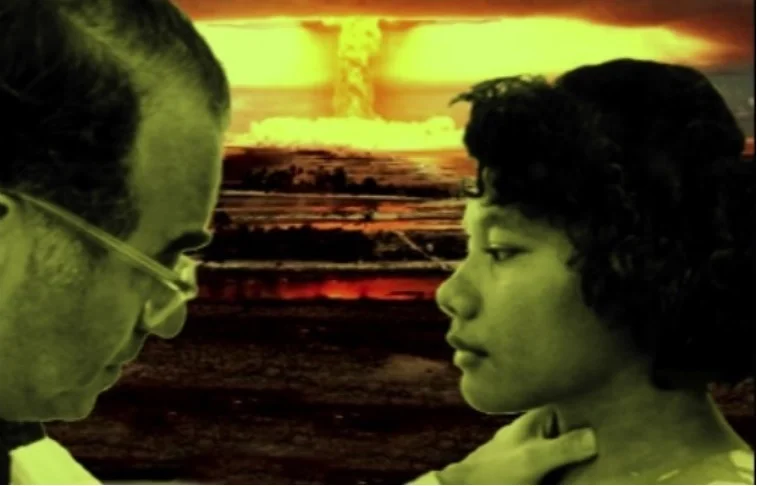2018
Pasatiempo
SFIFF 2018 - "Nuclear Savage" and "Atomic Artist"
Santa Fe's own Adam Horowitz, producer, writer, and director of Nuclear Savage, begins this unsettling documentary on secret radiation experiments conducted on Pacific Islanders with a brief history of the Marshall Islands, from the first European contact there to the devastating tests on Bikini Atoll starting in 1946. Early in the film, footage is shown of the Castle Bravo detonation over the atoll, a 15-megaton hydrogen blast that, in addition to its deleterious impact on the environment, took an immediate and lasting toll on the health of human populations. In the 12 years after that first test, the U.S. government detonated nearly two dozen such devices in the area. That number increased to 67 by the end of the Cold War. The race to remain ahead of the Soviets in the development of nuclear weapons became the justification for denying the islanders the privilege of their humanity, with government officials choosing instead to regard them as simple savages.
Parts of the islands remain uninhabitable, their residents unable to return to their homes due to high levels of radiation. They live in squalor on other islands, displaced by the thousands. The Marshallese government official in charge of foreign affairs from 2008 to 2009, when the film was in production, calls for greater scrutiny of U.S. documents that were declassified in 1993. These files lend weight to suspicions of cover-ups on the part of the American government concerning the deliberate radiation poisoning of island inhabitants. Horowitz presents credible evidence and does a fine job tying information that's been available to the public for years with new information gleaned from the government's Project 4.1, strongly implicating it as a top-secret operation to study radiation effects on unwitting subjects.
It's hard to refute the eyewitness testimony recounted in the documentary. One islander, a middle-aged woman, states plainly and wistfully, "They wanted to find out what would happen to us from the bomb. They used us as human experiments." Video footage is shown of islanders from Rongelap Atoll who were exposed to heavy fallout from the Bravo blast and suffered severe radiation burns. No action was taken to see that the several hundred inhabitants of Rongelap were evacuated before the test. Young children were born with deformities or cancer, people's hair fell out, and islanders began dying of cancer at alarming rates.
Nuclear Savage is compelling, disturbing, thought-provoking filmmaking, in which Horowitz contrasts the idyllic music and customs of the islanders with footage of horrific events. Funded by Pacific Islanders in Communications, a public broadcasting company that provides programming to PBS, Nuclear Savage is a damning look at America's presence in the Marshall Islands, and is an important, timely documentary. The film has won numerous awards at international festivals, including several jury prizes, and was an official selection at the Film Society of Lincoln Center in New York. An official screening was sponsored by the United Nations in 2015 in conjunction with nuclear nonproliferation hearings.
Horowitz is the artist who gave Santa Fe Fridgehenge (or Stonefridge), a Stonehenge-inspired public work of art built out of discarded refrigerators that was torn down in 2007 when city officials deemed it unsafe. He was involved in the recent removal of the replica Trinity Site monument that was erected on Marcy Street in front of the convention center this summer in advance of the Santa Fe Opera's run of Doctor Atomic. The removal was staged as a theft, although the city was aware it was being removed beforehand. Somehow, that event seems a fitting coda to Horowitz's role as provocateur and a voice of conscience in the nuclear age.
Artist Tony Price (1937-2000) was just such a voice of conscience. Atomic Artist, Santa Fe-based filmmaker Glenn Silber's short documentary on the sculptor, co-produced by Claudia Vianello, begins with views of the New Mexican landscape that are elegiac in their stillness and absence of people. When Price's sculptures, situated amid these landscapes, come into view, one has the impression of a future world where godlike metallic figures have outlasted the civilization that created them. The effect is amplified by a subtle but haunting score.
Using refuse metals salvaged from the Los Alamos National Laboratory's nuclear weapons program, Price transformed the products of a life-threatening industry into luminous artworks that pay homage to the iconography of world religions, sometimes with a biting humor. The film gives audiences a chance to hear Price discuss his work in his own words, although he is sometimes clearly reticent to do so, instead standing silently beside his friend Ed Grothus, a former Los Alamos technician and weapons specialist turned shop proprietor dealing in salvaged material. Price lets Ed do all the talking. But after a long night together locked in intense conversation, Silber manages to cull from Price a revealing testimony. "The concentration of a person is going to lead him to the truth, whether it?s music or just plain thinking," the artist states. "It's concentrating your energies to come up with something new, to come up with something that you already seem to know but haven?t been able to crystallize before." The ideas that drove the artist possess an archetypal presence, captured in close-up, reverent views by Silber that amplify their mystical qualities.
While Horowitz's film shows the grievous cost of the nuclear arms race, Silber's shows one thing that can be done to counteract our horror in the face of it: Turn weapons into art.
By Michael Abatemarco
Read Article Here
Also mentioned in NuclearNews.net
Read Article Here


